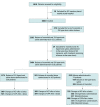Comparison of Intracranial Pressure Measurements Before and After Hypertonic Saline or Mannitol Treatment in Children With Severe Traumatic Brain Injury
- PMID: 35267036
- PMCID: PMC8914575
- DOI: 10.1001/jamanetworkopen.2022.0891
Comparison of Intracranial Pressure Measurements Before and After Hypertonic Saline or Mannitol Treatment in Children With Severe Traumatic Brain Injury
Abstract
Importance: Hyperosmolar agents are cornerstone therapies for pediatric severe traumatic brain injury. Guideline recommendations for 3% hypertonic saline (HTS) are based on limited numbers of patients, and no study to date has supported a recommendation for mannitol.
Objectives: To characterize current use of hyperosmolar agents in pediatric severe traumatic brain injury and assess whether HTS or mannitol is associated with greater decreases in intracranial pressure (ICP) and/or increases in cerebral perfusion pressure (CPP).
Design, setting, and participants: In this comparative effectiveness research study, 1018 children were screened and 18 were excluded; 787 children received some form of hyperosmolar therapy during the ICP-directed phase of care, with 521 receiving a bolus. Three of these children were excluded because they had received only bolus administration of both HTS and mannitol in the same hour, leaving 518 children (at 44 clinical sites in 8 countries) for analysis. The study was conducted from February 1, 2014, to September 31, 2017, with follow-up for 1 week after injury. Final analysis was performed July 20, 2021.
Interventions: Boluses of HTS and mannitol were administered.
Main outcomes and measures: Data on ICP and CPP were collected before and after medication administration. Statistical methods included linear mixed models and corrections for potential confounding variables to compare the 2 treatments.
Results: A total of 518 children (mean [SD] age, 7.6 [5.4] years; 336 [64.9%] male; 274 [52.9%] White) were included. Participants' mean (SD) Glasgow Coma Scale score was 5.2 (1.8). Bolus HTS was observed to decrease ICP and increase CPP (mean [SD] ICP, 1.03 [6.77] mm Hg; P < .001; mean [SD] CPP, 1.25 [12.47] mm Hg; P < .001), whereas mannitol was observed to increase CPP (mean [SD] CPP, 1.20 [11.43] mm Hg; P = .009). In the primary outcome, HTS was associated with a greater reduction in ICP compared with mannitol (unadjusted β, -0.85; 95% CI, -1.53 to -0.19), but no association was seen after adjustments (adjusted β, -0.53; 95% CI, -1.32 to 0.25; P = .18). No differences in CPP were observed. When ICP was greater than 20 mm Hg, greater than 25 mm Hg, or greater than 30 mm Hg, HTS outperformed mannitol for each threshold in observed ICP reduction (>20 mm Hg: unadjusted β, -2.51; 95% CI, -3.86 to -1.15, P < .001; >25 mm Hg: unadjusted β, -3.88; 95% CI, -5.69 to -2.06, P < .001; >30 mm Hg: unadjusted β, -4.07; 95% CI, -6.35 to -1.79, P < .001), with results remaining significant for ICP greater than 25 mm Hg in adjusted analysis.
Conclusions and relevance: In this comparative effectiveness research study, bolus HTS was associated with lower ICP and higher CPP, whereas mannitol was associated only with higher CPP. After adjustment for confounders, both therapies showed no association with ICP and CPP. During ICP crises, HTS was associated with better performance than mannitol.
Conflict of interest statement
Figures
Comment in
-
ADAPTing to a New Era of Comparative Effectiveness Research in Traumatic Brain Injury-Generating Evidence From Observational Data.JAMA Netw Open. 2022 Mar 1;5(3):e220899. doi: 10.1001/jamanetworkopen.2022.0899. JAMA Netw Open. 2022. PMID: 35267038 No abstract available.
References
-
- Centers for Disease Control and Prevention . Surveillance report of traumatic brain injury-related emergency department visits, hospitalizations and deaths - United States, 2014. Centers for Disease Control and Prevention, US Department of Health and Human Services. 2019. Accessed January 30, 2022. https://www.cdc.gov/traumaticbraininjury/pdf/TBI-Surveillance-Report-FIN...


